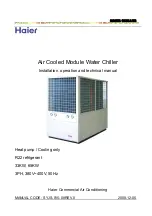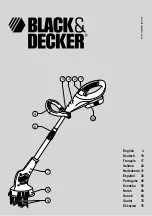
4. Mix together soap and water. This solution forms bubbles when leaking vapor passes
through it.
5. Use the soap solution to test around each unit fitting joint and weld seams carefully and
thoroughly.
6. To enhance the test, use an ultrasonic leak detector. These devices are reliable at finding
leaks in low pressure testing where soap bubble testing may not provide results.
7. When all leaks have been identified, vent the nitrogen vapor, make the necessary repairs to
the chiller, and repeat the gas pressure hold test until a satisfactory hold test is achieved.
Conducting the optional trace gas leak test
1. To monitor the system pressure over time, install a high-quality, high-resolution analog
pressure gauge on one of the shells. Use a pressure gauge that has a resolution of 2 psi
increments with a dial face at 3 in. in diameter or greater.
2. Before proceeding, make sure that the unit is at the initial evacuation level of 5 mmHg.
Important:
To prevent freezing of any moisture that might be in the system, do not go
below 5 mmHg. See
for more details.
3. With the system evacuated, charge with a vapor only for a 10% trace gas (R-134a) into the
chiller until the system pressure reaches 10 psig (69 kPa).
- When using a refrigerant-based trace gas, you must always charge with vapor only to
reach the initial 10 psig pressure.
- The use of trace gas must adhere to local policies in regard to venting or recovery of
the gas. This is dependent on the gas that is selected.
-
Important:
Use a suitable gas detection device that can detect the trace gas that
is selected.
- Set the gas detection limit for 10% R-134a based trace gas to 0.078 oz/year R-143a.
4. Add dry nitrogen into the chiller until the pressure reaches 100 psig (690 kPa).
5. To make sure that the concentration of trace gas has reached all parts of the system,
complete the following steps:
a.
Slightly open the condenser service at the liquid drain connection into the evaporator
service valve.
b.
Test for the presence of the trace gas with a leak detector.
c.
Continue to vent in this manner until the trace gas is detected and close the service
valve.
6. Before beginning the trace gas testing, ensure that any vented gas has been adequately
vented from the chiller area so that there are no false positive indications. It might be
necessary to reset the test probe in an outside space.
7. Test around each joint and factory weld carefully and thoroughly.
8. To check for tube or tube joint leaks, complete the following steps:
a.
Isolate and drain the evaporator waterboxes.
b.
Purge the waterboxes and tubes with dry nitrogen through the vents or drains until the
detector does not indicate any evidence of refrigerant.
c.
Close the vents and drains. Wait an hour.
d.
Open a drain and insert the leak detector.
9. If a tube leak is suspected, complete the following steps:
a.
Remove the waterboxes to facilitate application of the soap solution to the tubesheets.
b.
To test for tube wall leaks, insert a rubber cork in both ends of each tube, and leave
pressurized for at least 8 hours.
127
YVAM Control Center
Summary of Contents for YORK YVAM 0350
Page 2: ...2 YVAM Control Center...
Page 10: ...Figure 4 Variable speed drive nomenclature YVAM Control Center 10...
Page 15: ...Figure 8 System piping and instrumentation diagram P ID 15 YVAM Control Center...
Page 154: ...Figure 62 Sample printout status or history YVAM Control Center 154...
Page 155: ...Figure 63 Sample printout status or history continued 155 YVAM Control Center...
Page 156: ...Figure 64 Sample printout setpoints YVAM Control Center 156...
Page 157: ...Figure 65 Sample printout setpoints continued 157 YVAM Control Center...
Page 158: ...Figure 66 Sample printout schedule YVAM Control Center 158...
Page 159: ...Figure 67 Sample printout sales order 159 YVAM Control Center...
Page 160: ...Figure 68 Sample printout security log report YVAM Control Center 160...
















































